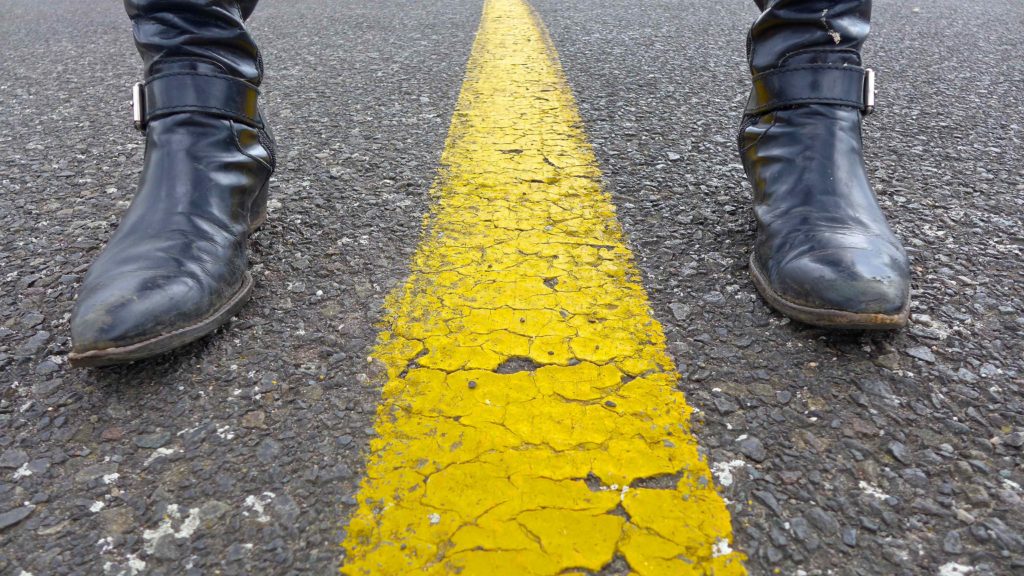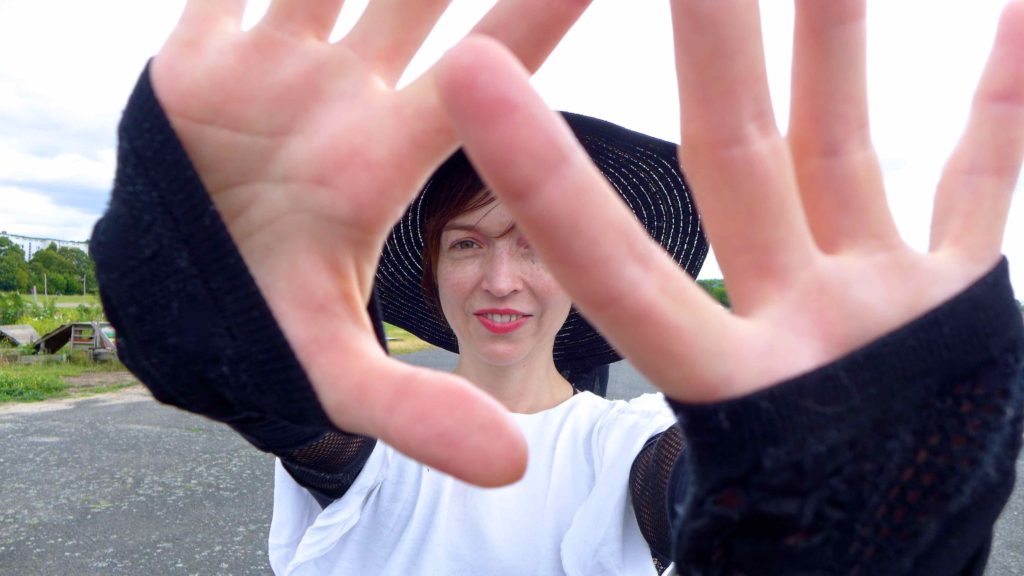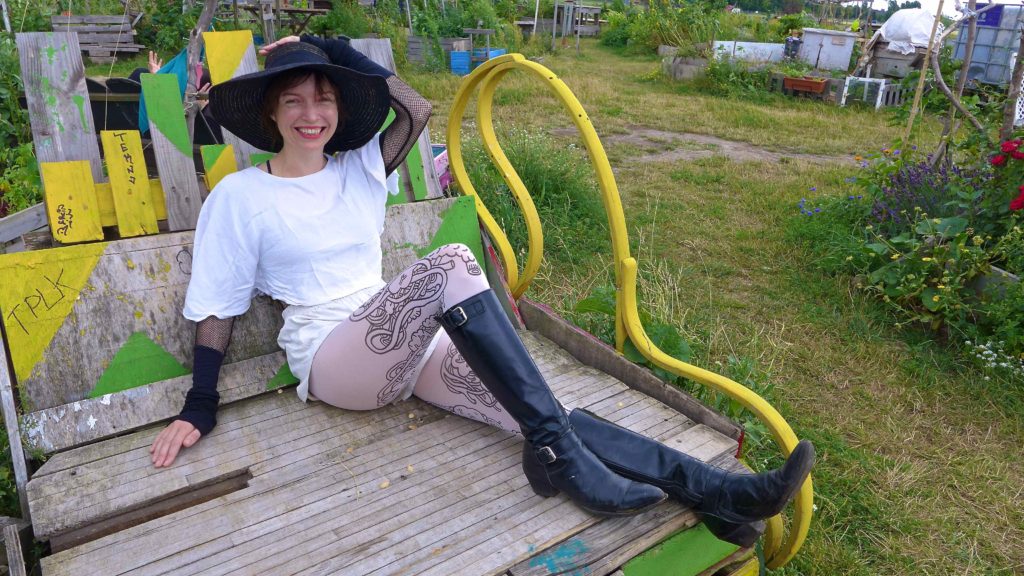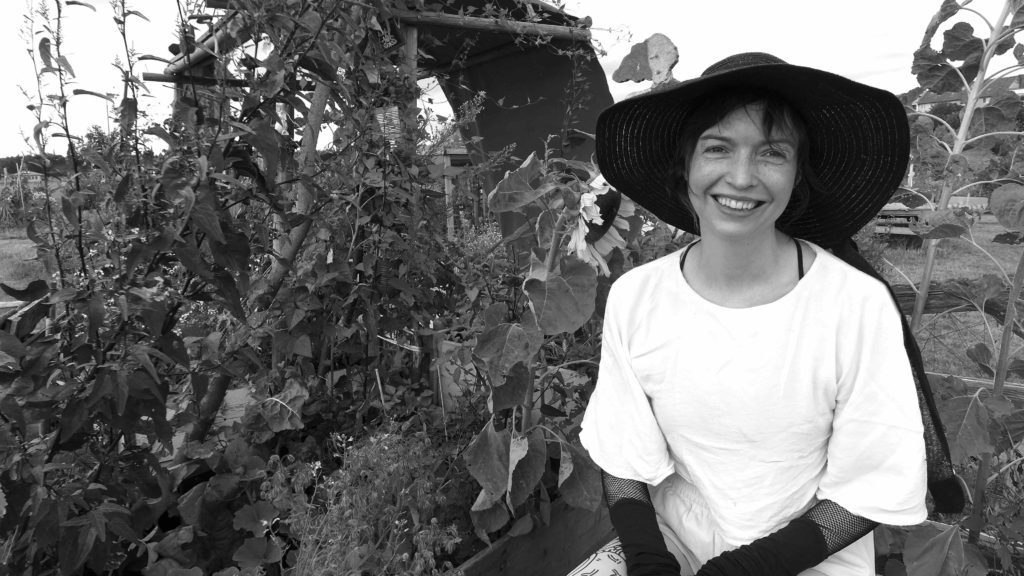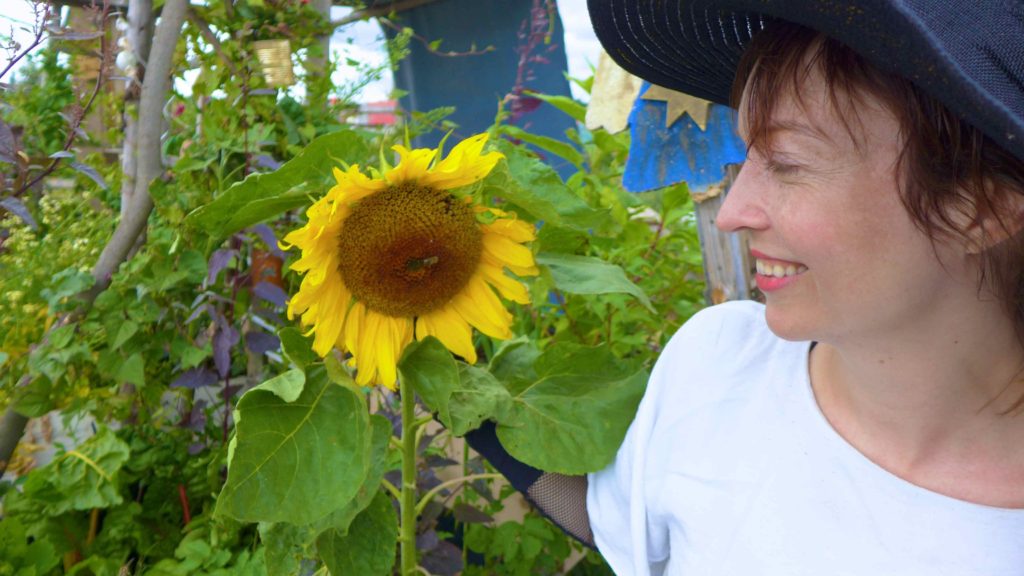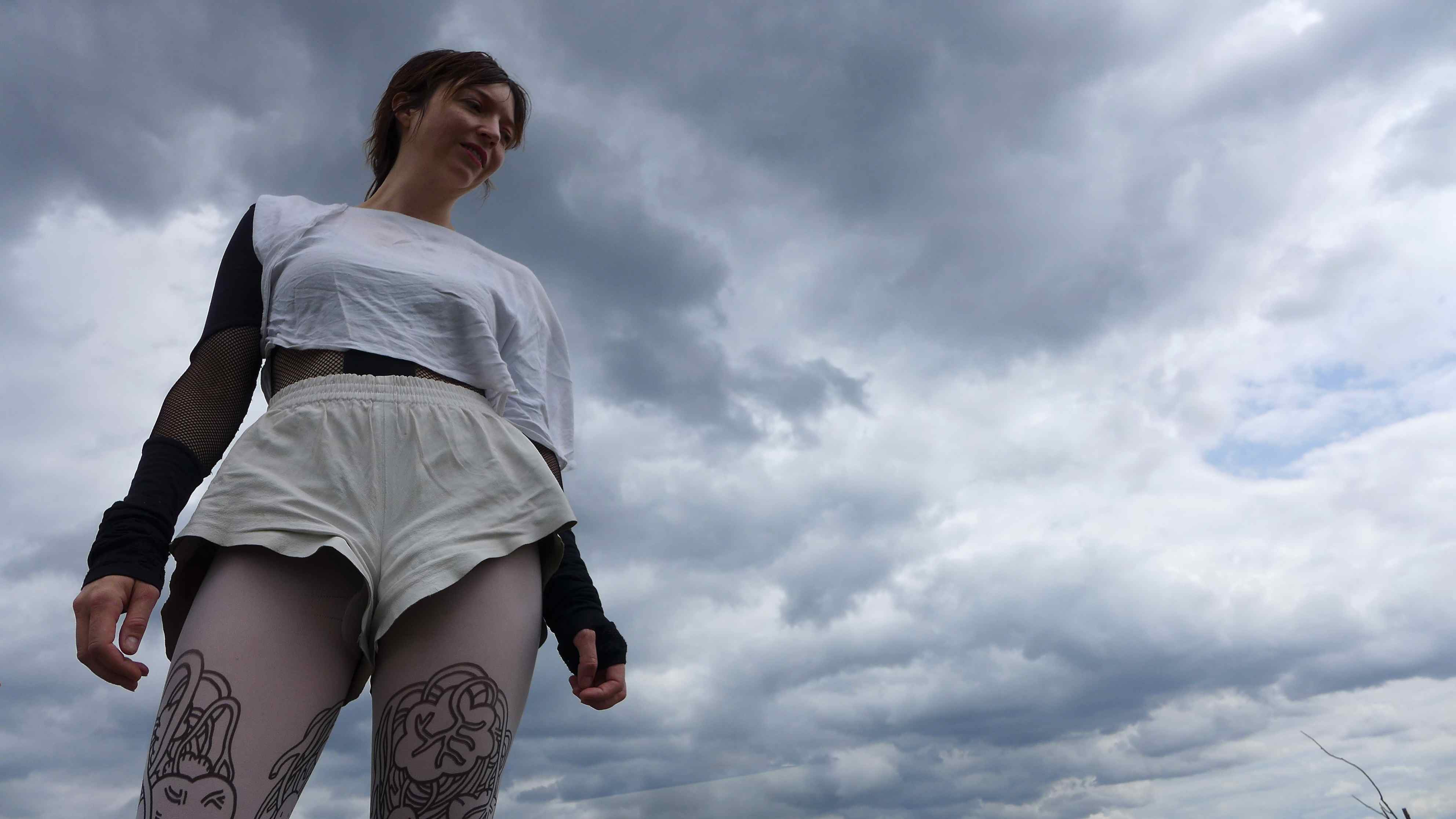
When I watch ‘Vaginal Knitting’, the video of Casey Jenkins’ performance installation Casting Off My Womb, I see a powerful, graceful figure at work.
With her beatific smile, the artist looks like some kind of angel as she sits there, back perfectly straight, quietly going about the business of knitting, using wool she has buried deep inside her vagina…
The yarn hanging above her is so pearly white it shimmers: the only thing that’s missing from this picture is a pair of wings. Wings that in my opinion belong to a bit of a superhero…
A simulacrum of historic portraiture also erupts from this moment of looking: centuries cascade across the image. It becomes a critical reflection on the historic act of men painting women – of men representing how women ‘should’ look to the rest of the world – through the rarefied, patriarchal, exclusive act of painting them.
Except in this instance ‘the portrait’ has been subverted, and cleverly perverted. For the author of this portrait is a woman, the woman in the picture. She has taken control: of her likeness, her body – and what happens to it – during the artwork. (It is a temporal still life.) While on the surface the ‘subject’ – artist Casey Jenkins – may resemble that of a Rembrandt or a Vermeer, this portrait is very unlike the depictions we’re so used to seeing by the so-called “masters”. No-one owns her; she owns her self. She has agency.
If we accept this art we must also accept it goes beyond boundaries of ‘taste’. It is a portrait happily, naturally, stained with the menstrual blood that defines the artist-subject’s sex. She demands that we accept femininity – and therefore by definition, that it is powerful on its own terms. It is creative, free, beautiful, messy, real, radical, political, and, as valid as any art created by a man.
Perhaps this is why Casting Off Her Womb caused such controversy: within the silence of this contemplative, profane work is a defiant questioning of not only the validity of male representation of the female form (via art, throughout eons of history), but the validity of male art, period. The work demands that we validate Casey’s right to flout conventions of taste, thereby ‘unsilencing’ femininity within art and culture.
Maybe that’s what stuck in everyone’s craw – that it was an implied “fuck you” to not one or two, but generations of revered male artists, towards whom we have historically ‘looked to’ for moral guidance and the definition of beauty. It’s a “fuck you” to our collective fall back position of “father knows best”…
And that she dared to use her own body as the site of this subversive commentary.
Ironic then that such a still, contemplative work would cause such a loud, surging, abrasive noise – and an ugly, frenzied, thuggish controversy. So far seven million-plus people have viewed the video: it was – and continues to be – a “Yoko Ono” moment.
Do we really hate women’s bodies that much? Is artistic expression really held ransom to “good taste”? Are we really that ‘sex negative’? Judging from the plethora of comments posted beneath that video, the answer is overwhelmingly, resoundingly “yes”. Gulp.
When I saw Casting Off My Womb – photos of it, news articles, eventually the video that triggered the flurry of outrage – I was gob-smacked. I felt really proud to be a woman, to be represented in such a way. I thought Casey was heroic. The work tickled me pink.
So when I found her one day, in Berlin, sitting at my friend’s kitchen table, I told her so. Then I signed her up for a chat – and a photo shoot in the city’s free-est space: Tempelhofer Feld, an airport confiscated from fascists and returned to ‘the people’. It smacked of poetic justice.
There she was – the woman who’d spent an entire month quietly sitting knitting in a gallery! The artist who’d dared to weave an infinite woolen ‘scarf’ from the depths of her vulva! The craftivist who’d gracefully endured one of the most prodigious internet controversies in recent history!
By all accounts, Casey’s experience was truly a “psychological endurance performance artwork” – one that only someone with a wee bit of a superpower could endure…
Circus Folk: Casey Jenkins: “activist, craftivist, rabble-rouser”… Do you recall the first time you were ever creative?
Casey Jenkins: I have done a lot of my creating as part of groups and posses and that probably stems back to my childhood; I was big into secret societies as a kid. I really wanted to be a spy and remember poring over a lip-reading book in the local library after school, thinking I could kind of make it my super-power…
My sister and cousin and I formed our own posse around that time called ‘Cool Dudes Club’ and wrote each-other letters in code, mainly plotting important things like midnight feasts.
CF: And the first time you were ever “crafty”?
CJ: I designed a nappy for my baby brother using cottonwool, gladwrap and litmus paper I’d nicked from science class. It would change colour when he pissed so you didn’t have to stick your hand in to check.
I think someone manufactures something similar now.
CF: Where did your love for ‘making’ come from do you think? Did you have any particular influences or mentors in your life who helped form your sensibility?
CJ: Maybe I’d say I’m driven to express, rather than “make”? I’m not sure if there should be a distinction there?
“Making” to me seems to imply the creation of tangible things whereas I feel I’m more driven to try to articulate ideas. I do love wielding tools and the satisfaction of solid creations, but much of what I create is ephemeral.
My desire to express myself comes from indignation and a desire to chuck a spanner in the works of the Patriarchy which only gives voice to rich old white men or those who champion their plight.
Particular influences were a domineering father and a student exchange with Rotary, the ultimate boys club. But the world abounds with bigots who inspire me to action.
Some of my artistic heroes and inspirations include LA based sculptor Charles Ray; Japanese-British writer Kazuo Ishiguro; country singer Dolly Parton; Russian all-women punk group Pussy Riot, and Belgian-born, Mexico-based artist Francis Alÿs.
CF: What do you love about making art?
CJ: It gives me clarity, it focuses chaos and despair and channels them into a path of transformation.
CF: And craft?
CJ: The rhythmic physicality of it is grounding and satisfying. I love the quiet sense of camaraderie and generosity in craft communities.
CF: I first discovered your work and “craftivism” via Anna Brownfield’s* documentary Making It Handmade, where you were interviewed as part of the Craft Cartel, a collective that uses craft to demonstrate against discrimination. Would you tell us a little about the Craft Cartel, why it was set up, what you made, and some of the ‘actions’ you did?
CJ: I co-founded Craft Cartel in 2007 with Rayna Fahey, who runs Radical Cross Stitch Posse. We were interested in people making craft on political and activist themes but there was nowhere for them to display their work – too rough-hewn and humble for galleries and not commercial enough for craft markets.
Most craft markets charge a lot of money to have a small table space and unless you’re making masses of cutesy mainstream stuff it’s not affordable – so we set up our own dirt-cheap market just for radical craft in a city bar and called it Craft Cartel.
We later also had pop-up street markets called ‘Flock n’ Flogs’ by-passing council regulations and just keeping an eye out for cops and suits.
Mainly though we wanted to move away from the connection between craft and commerce altogether so we started doing street-art actions, a podcast and produced a series of group activism events called ‘Trashbag Rehab’.
We taught a basic craft technique to a bunch of people in a pub and together creating an activism project such as making crocheted explosives to protest the proposed pulp mill in Tasmania.
Craft Cartel is more of a ‘sleeper cell’ now. It comes out of hibernation for important events, such as before the 2013 election that saw conservative nitwit Abbott take power. I organised a national protest banner action called “Knit Your Revolt”.
Over a hundred knitters from around the country contributed pieces [to it].
CF: Do you have a particular philosophy around your work? What motivates you? And what kind of conversations are you interested in having with the public?
CJ: I’m seeking honesty, transparency and equity. I feel hypocrisy, duplicity and shame are at the root of most of the systems and behaviours that stymie us, domestically, politically, locally and globally.
I’d love to have well measured calm and thoughtful conversations with others without needing to censor or hide myself. You can only control how you behave in an interaction though so I’ll just keep making art and wait until the world is ready to engage calmly.
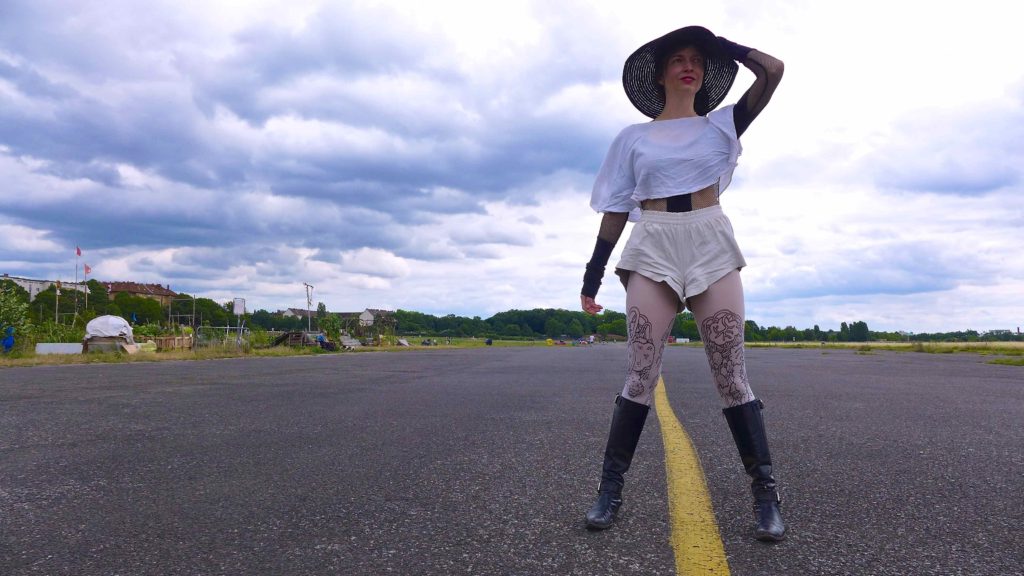
Photo: Megan Spencer (c) 2016
CF: Casting Off My Womb has been a bit of a “journey” for you to say the least! How would you describe it, from when you began it in 2013 until now?
CJ: The reaction was overwhelming and staggering. Very weird. I felt like I’d gone through the internet worm-hole. I had people approaching me in the street and photographing me when I was out in public and journalists hounding me for a while. It felt quite ruthless.
I sort of thought all the negativity in the web comment streams had washed over me but compiling them for my most recent piece, Programmed to Reproduce (a psychological endurance work in which I, in part, recited and absorbed some of the abusive comments directed at me over 35 hours), I realised they’ve made me wary and insecure in some circumstances. And that is how the patriarchy is policed – through relentless shaming and belittling.
I realise that I was being used as a sort of example or warning to other artists who present as women not to put their head out or do anything that didn’t accord with common standards of feminine behaviour or they’d cop the same sort of reaction. I have no intention to be used this way and am really enjoying venting by recreating some of the more common web abuse as large-scale knitted banners with a touch of menstrual blood dyed yarn.
CF: What was your intention behind Casting Off My Womb?
CJ: Casting Off My Womb was an exploration of the dissonance between society’s gendered expectations of individuals, and an individual’s potential and desire. Knitting, the vulva and menstruation are currently inextricably linked to notions of womanhood in the popular imagination, each with strong stigma attached.
“In ways that sometimes seem contradictory to me: it made me feel fragile and strong, wary and determined.”
I am fascinated by how incompatible those stigmas are though they all feed into this mythical idea of what being a woman is: “knitting is for grandmas”, “vulvas are for sex”, “menstruation is for baby-making” – those concepts do not sit together in the current cultural paradigm, and all have elements of embarrassment and shame.
Combining these concepts in my work created the disconcerting effect that I think people responded to. We have a strong compulsion to categorise and judge people by gender, with Casting Off My Womb I was hoping to give people pause to consider how illogical and unstable those categories are.
As a menstruating person in my mid-thirties, there was a strong expectation and pressure from society that what I should do (and should want to do) with my body and my life, was to bear children.
In Casting Off My Womb I created a long knitted passage to mark one full menstrual cycle, and to quiet down the noise and distortion of gendered expectations to consider what I, as an autonomous individual, want to create with my body and my life.
CF: Stepping back from it all, I can see, as the creator of Casting Off My Womb, that there has been quite a long ‘arc’ of experience for you over time: from the execution of the work back in 2013, until now, and it still endures… What was your experience like during those first 35 hours: physical, emotional, mentally? I’m intrigued as to what it might be like to go through something like that, and the changing nature of that experience throughout that duration.
CJ: Generally (and hopefully!) when I begin a performance work, most of the legwork – the production, staging and logistical aspects – have been completed so I can immerse myself in the process of the piece.
Casting Off My Womb was a very slow meditative work and my experience of it was calming. It was a quiet, gentle and rhythmic piece. People who visited the gallery were engaged and respectful, some came and chatted to me while I knitted, so it was quite casual.
CF: And the moment it was over? What was that like for you?
CJ: I remember feeling satisfied – looking back on it and feeling content that I had created a work that felt strong and complete to me. The SBS2 video didn’t air until a couple of weeks after the performance was over; I’m glad that I had that time to consider and weigh the work on my own [terms] before interweb mobs joined the conversation…
CF: And now: where has it moved to for you, given the myriad of responses?
CJ: It’s been a fascinating journey: Casting Off My Womb was such a quiet, slow and gentle piece to perform that the mass of web commentary felt loud and discordant with it for some time.
Now that I’ve started to address those reactions – with the endurance piece Programmed to Reproduce and by knitting banner replicas of web comments – it seems the responses to my work are becoming more circumspect, which is heartening.
CF: As we’ve talked about, you have received a wide array of responses about it, from essays in academic journals to an “online backlash” from hate-trolls.. What are some of the more positive or interesting responses or commentary you received?
CJ: I’ve had some really touching emails and personal encounters, and have felt incredibly honoured that some artists have responded by using my piece to create works (paintings, poems, sound pieces) of their own.
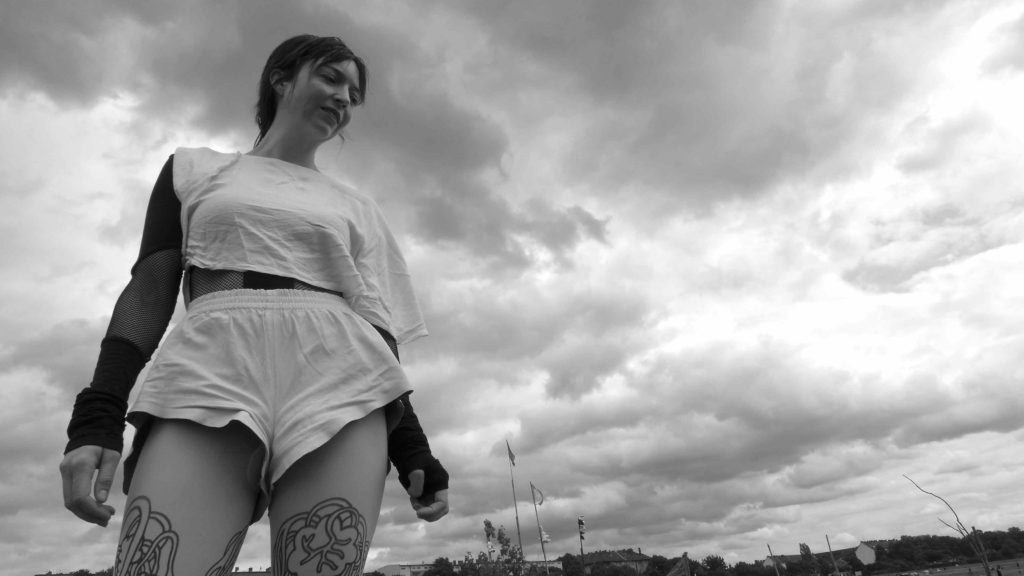
Daring greatly: Casey Jenkins. Photo: Megan Spencer (c) 2016
CF: And the online bullying: what kind of shape did that take? And how did you (are you) weather/ing that?
CJ: It was overwhelming: there were tens of thousands of comments but all expressing similar core sentiments. So I filed them into categories: “crazy”, “attention-seeker”, “not-art”, “she should be shot”, “disgusting”, “I’m gonna knit from my arse” etc.
The prevailing wisdom is “don’t read the comments”, but I didn’t want to hide from them. I thought by doing the endurance performance, Programmed To Reproduce and reading and absorbing them for hours I might somehow become immune to them, but actually they really wore me down. By the end I felt sad and depleted.
The only counter for it is to seek the company of good, kind people.
CF: What fears about women, women’s bodies, feminism (or anything else for that matter!) do you think that kind of one-sided aggressive reaction revealed about our culture and society, especially about women?
CJ: Wading through the reams of comments and seeing how predictable they were, how people move en masse reinforcing staid ideas gave me an insight into how cultural norms are perpetuated. I think people are terrified of not being accepted. They are much more likely to make comments, positive or negative that are supported by an authority in the community.
Huffington Post have written several ‘articles’ about my work over the past few years – they started off hyperbolic and the comment sections mirrored this, often just parroting the headline verbatim with a few emojis thrown in. Recently their articles have taken a much more positive turn and negative comments have lessened considerably.
People just want to be on the winning team and not be ostracized from the crowd, even if it means putting other people down to be there.
CF: What kind of censorship occurred around the work?
CJ: Lots of news reports added boxes and stars to cover my pubes (that was all that was visible in the video by SBS2) and big NSFW (“not safe for work”) banners. The Vaginal Knitting video now has an 18+ entry requirement – I’m not sure whose decision that was.
And I was told “off the record” by an employee, that a city gallery didn’t want to exhibit my work because of the potential controversy…
CF: Has the experience changed you as an artist?
CJ: Yes, in ways that sometimes seem contradictory to me. It made me feel both fragile and strong, wary and determined.
CF: And what happened to the artwork – the giant textile that you created during that month? It looks like a giant scarf…
CJ: The length of knitting that I produced during Casting Off My Womb – although it was widely reported as being a scarf – it isn’t one.
I can understand why people would believe that it visually alludes to scarves [as] it is about 12 meters long. [But it’s] not intended to be an item of clothing at all. It is a marker of a period of time in my life, that is all – more like a ticker-tape than a scarf.
I think part of the reason people jump to the conclusion that it is a scarf is the insistence that “women’s work” must produce something practical, something of service to others – not simply [be] an expression of ideas. However that is what it is: an expression of my ideas: not wearable or of practical use to anyone in any manner.
At the moment it’s sitting in an airtight bag in my fridge. I displayed it at the Festival of Live Art in Melbourne earlier this year as part of my Programmed to Reproduce performance. I will show it again in December at the Venice International Performance Art Week for my new piece sMother. And the ABC will be filming a little grab about the work for a program: a little grab about the work for a program they’re making about “art that has caused controversy”…
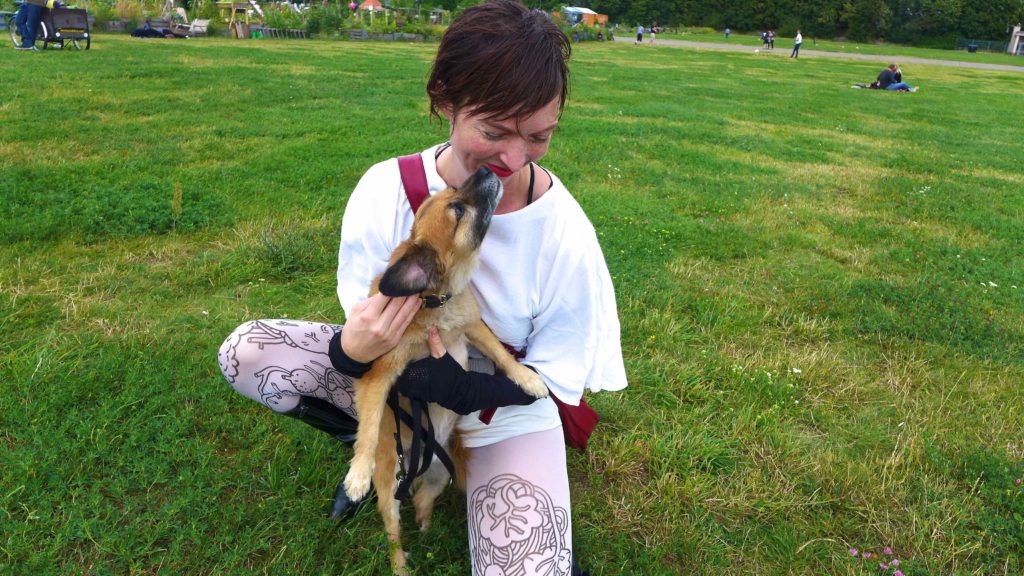
Pauli hearts Casey. Photo: Megan Spencer (c) 2016
CF: Finally, please finish this sentence: “You know it’s been a good day when…”
CJ: …When you’ve been swimming. It’s hard to not realise how wondrous the world is when you’ve spent part of the day suspended in liquid blue.
Huge thanks to Casey Jenkins for the interview and photo fun in the ‘Feld!
- Interview: Casey Jenkins
- Words, edit + photos: Megan Spencer
- Visit: Casey’s website
- Watch: Vaginal Knitting
- View: my Casey Jenkins photo gallery
- Follow: Craft Cartel
- Listen: Craft Cartel podcast
- Check out: Radical Cross Stitch
- Watch: Making It Handmade
- Visit: DVAA
- *Disclosure: Anna Brownfield and I go way back! ; )

